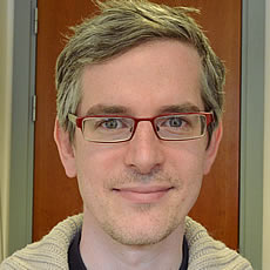Dr Raymond Reynolds
Supervisor Details
Research Interests
Vestibular control of posture - How does the brain transform vestibular signals into appropriate responses for balance? Galvanic Vestibular Stimulation induces a sense of head movement. The resulting sway response reveals mechanisms underlying sensorimotor control of standing.
Tremor - Fourier and wavelet methods are used to examine the relationship between muscle activity and hand movement during static postures. This can distinguish between neural and mechanical origins of physiological tremor.
Neural basis of online visual control of movement - Target jump paradigms reveal the neural mechanisms underlying online control of reaching and stepping, both in healthy individuals and stroke patients.
Scientific Inspiration
I can think of many inspirational characters in science, but the common attribute they have is the ability to generate independent, novel ideas which change the way we think, as opposed to small incremental mass-produced science.
Project Details
Dr Reynolds is the supervisor for the below project:
The integration of visually-guided interception with balance
Secondary Supervisor(s): Professor James Tresilian (Warwick), Dr Sang-Hoon Yeo (Birmingham)
University of Registration: University of Birmingham
BBSRC Research Themes: Understanding the Rules of Life (Neuroscience and Behaviour)
No longer accepting applications
Project Outline
Control of fast interceptive movements is the highlight of human sensorimotor behaviour, whose flexibility and adaptability far surpasses that of any existing robot. The neural control mechanism of interceptive movement remains elusive. For example, when an object that we are reaching for moves unexpectedly, the hand is ‘magnetically’ drawn towards the new object location. These trajectory adjustments occur within a remarkably short latency (<100ms), do not require conscious awareness of the change, and may rely upon sub-cortical neural circuitry [1]. We have demonstrated that this exceptionally fast visuomotor system also controls the lower limb when attempting to step onto a moving target [2]. However, when standing, such automatic adjustments may threaten balance, which is also largely controlled by sub-cortical brain circuitry. For example, reaching for a moving object (e.g. catching a ball), causes a concomitant shift of centre of mass which disturbs balance, but we rarely fall. The apparently contradictory requirements of reaching and balancing must therefore be somehow seamlessly integrated at a low neural level. Staying upright in the face of such self-imposed perturbations is natural for humans, but we still do not understand the underlying mechanism(s). For example, attempts to implement such control into bipedal robots often leads to catastrophic falls (see DARPA challenge https://bit.ly/1Il2QVS). This failure to coordinate interception and balance can also lead to human falls as a result of neural degeneration (e.g. ageing).
We plan to investigate the integration of these two systems, balance and interception, at both a behavioural and neural level, to address the following questions: How are balance and visually-guided interception integrated, and what are the limits of this process? What neural circuitry underlies this integration? How does normal ageing affect the integration process, and what are the consequences for fall risk? We will address these questions using a combination of techniques from Biomechanics, Neurophysiology and Robotics. To study the integration of balance and interception we will use virtual reality to present visual interception targets. This will allow us to subtly manipulate the relationship between hand and target motion [3]. Limb trajectory will be recorded using motion capture and processed in real-time to manipulate visual feedback. Balance will be simultaneously assessed by measuring ground reaction forces and full-body motion capture. The limits of the integration process (i.e. when do you fall?) will first be tested in young healthy individuals. To understand the neural circuitry we will use Transcranial Magnetic Stimulation (TMS) [4], Electromyography and H-reflexes. These techniques will allow us to determine the relative contribution of cortical and sub-cortical brain areas to these behaviours. This, in turn, will also have relevance for understanding rehabilitation of balance following brain injury. Finally, we will study older adults. This will determine the extent to which the ability to combine interception and balance is compromised by the ageing process, and the relevance for fall risk.
References
- B.L. Day, P. Brown, Evidence for subcortical involvement in the visual control of human reaching, Brain. 124 (2001)
- R.F. Reynolds, B.L. Day, Rapid visuo-motor processes drive the leg regardless of balance constraints, Curr. Biol. 15 (2005).
- S.H. Yeo, D.W. Franklin, D.M. Wolpert, When Optimal Feedback Control Is Not Enough: Feedforward Strategies Are Required for Optimal Control with Active Sensing, PLoS Comput. Biol. 12 (2016).
- W. Marinovic, C.S. Reid, A.M. Plooy, S. Riek, J.R. Tresilian, Corticospinal excitability during preparation for an anticipatory action is modulated by the availability of visual information, J. Neurophysiol. 105 (2011).
Techniques
- Matlab & Simulink software will be used to acquire and analyse data. This will provide the student with advanced programming skills which will benefit their future employability.
- Motion Capture will be used to study hand movements. This is a ubiquitous technique used in numerous biomechanics and motor control laboratories worldwide.
- Neurophysiology. Transcranial magnetic stimulation is an important technique for investigating and manipulating brain function, and has steadily grown in use over the last 3 decades.
- Virtual Reality will be performed using the HTC Vive Pro system.
- Time-series analysis and statistics will be undertaken using Matlab and JASP/SPSS/R.
